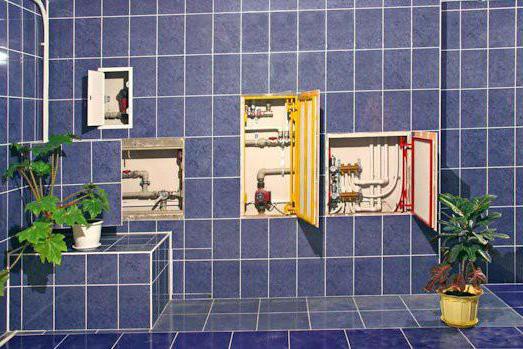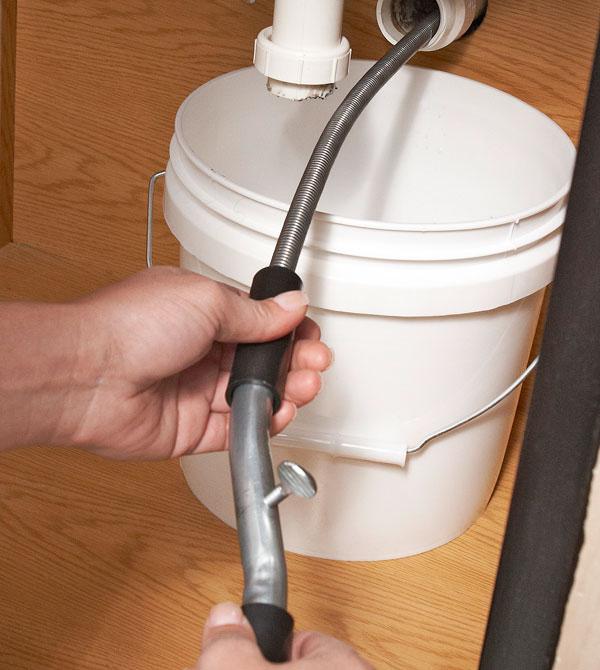How to close pipes in the bathroom: ways, technologies, materials
No matter how original and stylish the design is inbathroom, the whole effect can easily come to naught. The fault of all the pipes, which are very striking. To save the situation, you need to remove these communications away. Let's look at how to close the pipes in the bathroom so that you have access to them for service and elimination of accidents.
Selection of materials and requirements
The first and important criterion is a small mass. You should choose the material in such a way that fastening does not require the construction of heavy frame structures. Suitable wooden slats or aluminum profile.
Resistance to increased humidity is also important. Water in the bathroom is common. All that will be used in the finish, should not be exposed to the destructive effects of moisture. Preference should be given to such materials that will not absorb moisture, and also to change their shape in the presence of water on the surface.
Importance of resistance to a variety of chemicalimpacts. For cleaning in bathrooms and bathrooms use household chemicals. In the performance of general cleaning, all the elements of surfaces are often subjected to chemical treatment. Therefore, facing materials should easily transfer contacts with household chemicals.
Hidden pipes in a bathroom and a bathroom are alwayscorrect solution. The box can be made of plasterboard, MDF, plastic panels. You can also apply gypsum 3D panels. They are distinguished by a large selection of textures and can accurately simulate brick, wood, mosaic.

How to choose a way of camouflage engineering communications
There are many ways to close the pipes in the bathroom. Variants differ depending on the shape of the structure and the materials used. Let's look at the simplest and most popular solutions.
Box of plasterboard
For bathrooms it is necessary to purchaseDrywall, which is designed for use in wet rooms. From conventional analogs, it is distinguished by the presence of a special coating. The sheets are impregnated with impregnated and antifungal compounds. From ordinary drywall moisture resistant differs in color. It can be distinguished by the green shade of the surface.
As a basis for the future of the box will beA framework made of a rack-mount profile is used. The profile size is 27 x 60 millimeters. Guides will also be used. Their size is 26 x 27 millimeters. The supporting structure is constructed first, and already on this basis, gypsum cardboard sheets are cut into size.
Stages of manufacturing the box
First of all, mark the walls and floor. Having determined the most protruding point of the pipes on a vertical wall, you need to retreat from it about 3-5 centimeters and draw a line. The same principle is used when marking horizontal surfaces.

Then along the line using dowels mountreiki. To do this, use a guide profile. To these racks fix crossbars from the rack-mount profile. The details are connected by crab fixers at a distance of 15-20 centimeters.
You need to create an amortization for the structure. For this purpose, a special tape is laid in places where it is adjacent to the pipes. Next, the finished construction is covered with strips of gypsum board. Installing sheets, you need to monitor the front side. It must be outside. In the process of screwing the screws it is necessary to heat their hats into the plasterboard.
After this, you can go on to manufacturing anddecorative design of the door. In the box a technological hatch is cut. To hide it, the door is seated on the hinges. Then, the body and the door are finished with the hinges.
Tips of the master
A demountable tubing box in the bathroom is rubbed offgrater, plastered with a thorough fit of all the seams. To strengthen the strength of the finished box before the putty, it is recommended to equip the corners with a perforated corner. In order to putty put better on the joints between the sheets, the edges of the drywall are chamfered. If this design will hide the communications of the heating system or hot water supply, then in the upper part it is necessary to make holes - through them will come out warm air. In case of water leakage, an additional small hole is made at the bottom of the structure. This is necessary in order to quickly detect a leak and timely repair pipes in the bathroom.

In the process of fixing the profiles to the floor surfaceshould exclude the slightest bias. Any, even a small error affects the quality of the structure. It will look ridiculous. If the floor and walls of the bathroom are tiled, in the drilling process, you must also pay attention - in inaccurate actions, tiles can crumble and crack. Especially it concerns ceramics. Use only special drills, not universal drills.
Using ceramic tiles
This process is very similar to working withplasterboard. But to hide the pipes under the tiles in the bathroom, it takes much more effort. The main advantages of ceramic tiles: beautiful appearance and good moisture resistance. The design of tiles easily fits into any design, while communications will be invisible, an additional area is created for storing small items useful in the economy. The coating can be matte or glossy. The hue of the tile should not differ much from the overall design of the bathroom. Only so the box will fit well into the interior.

Let's look at how to close the pipes in the bathroom withusing the finishing of tiles. As a basis, a metal or wooden frame can be used. When working with wood, all elements are pretreated with water-repellent compounds. This is important, because such material immediately "leads".
To simplify the task and to prevent possibleerrors in the process of installation work, it is better to make an approximate sketch of the design with all the important dimensions in advance. Also, it is not superfluous to make a designation of the places of fixing the elements of the box. This will greatly simplify the installation process.
Stages of manufacture
First of all, the zones wherecommunications. Then, from a wooden strip or metal profile, a frame is made, which is then securely fixed to the surface of the floor, walls and ceiling. After that, the base is covered with any available material. It can be a moisture resistant plywood or chipboard.
The front part of the structure must have a hatch-repair or installation of pipes in the bathroom will be much easier. The facing material (in this case chipboard or plywood) is pasted with reinforcing mesh. Next on the grid put a ceramic tile. To glue the net you also need the service hatch door. The seams between the tiles are mashed, and then covered with mastic against the fungus.
Ideas of specialists
The design and shape of the framework in many ways determines what,how the pipes are laid in the bathroom wall. With the help of the protrusion, you can hide the communications passing in the combined bathroom. In this case, a built-in drain tank hides in the box.
You can hang the structure on the level of the shell. This solution will not only hide from the eyes of the pipe, but also provide an additional place where you can store household chemicals and other necessary things.

As doors it is possible to apply already readyplastic products. Their assortment is quite wide. The presence of a inspection hatch is very important if the pipeline has meters, valves or other controls. Otherwise, you have to disassemble the construction in order to verify the meter reading or to cut off the water.
We use plastic panels
Decorative panels for the bathroom - it's simple andAn affordable way to hide the pipeline. Due to the wide color gamut of these panels, it is possible to create designs for any interiors. Convenience is also in the fact that each panel element is easily interchangeable. This greatly simplifies the tasks when a partial disassembly of the structure is needed.
The only minus of plastic panels for the bathroom- low fire resistance. Although most manufacturers give a guarantee that in the event of a fire, the product will only smolder, but the smoke is no less dangerous to the human body.

Installation of the panels is done on the readyskeleton. The same metal profile is used as the basis. Before starting the carcass plating, the starting molding is attached to it using self-tapping screws. To hide the head of the screw, the fixation is performed through the shelf, which is covered by the next panel.
In the molding, the cut preforms are introduced. They are strung one after the other. Each panel should be tightly pushed to the end. And for reliability, its free side is fixed with self-tapping screws. When docking adjacent panels, the edges must firmly fit into the locks of the already installed panels. At the end of the installation work, an external molding is installed. It also eliminates the connection between the frame and the floor or ceiling surface.
Here's how to close the pipes in the bathroom with plastic panels. In fact, if you have certain skills, it's not so difficult. The main thing is to be attentive and accurate.
We hide pipes radically
You can hide communications in a more crude way. They zamorovyvayutsya directly into the wall. So you can hide not only communications, but also add a little space to the bathroom or the bathroom. It should be borne in mind that, according to the building standards, it is not allowed to pile a brick wall-partition and a thin-walled partition in panel houses.
In addition, this work is quite difficult, the main drawback is the impossibility in a short time to gain access to the pipes in the event of an accident. Choosing this option, you should consider the risk of leaks.

There should be no connections in the wall. For installation use fittings and pipes made of polypropylene - they can easily be welded together. For the laying of communications of hot or cold water supply, the shroud must be equipped with a sleeve made of foam rubber or a thermofleth. These are the basic rules for building data communications in the wall.
Conclusion
So, we figured out how to close the pipes in the bathroomroom. As you can see, you can perform this operation in different ways. At the end of the works the interior in the bathroom will be really full and harmonious.
</ p>



